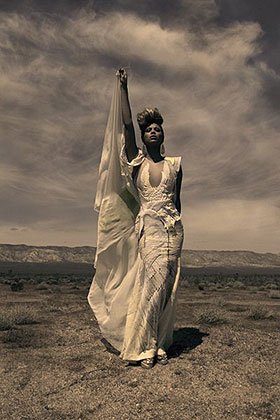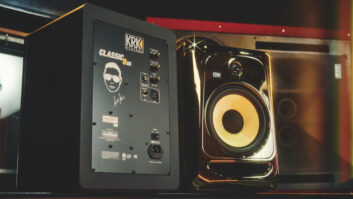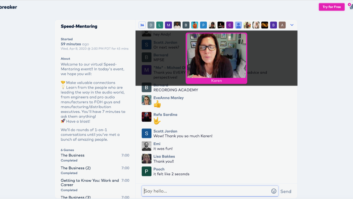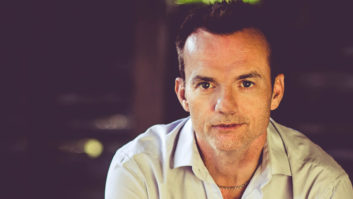
It only seems as though Beyonce has been a superstar forever. Since her days fronting the hit machine known as Destiny’s Child in the late ’90s, she has conquered the world with her four solo albums—selling 75 million records and picking up 16 Grammys along the way—triumphed on a succession of increasingly extravagant tours, been praised for her acting in several major feature films, launched successful fashion and fragrance lines, and become one of the highest-paid commercial spokespeople in the U.S. Her latest album, 4, was an instant smash when it was released in late June while she was on tour in France; two days after it came out, she headlined the Glastonbury Festival in England in front of 170,000 people. She’s beautiful, talented, independent—and driven.

One reason Beyonce has ascended to these lofty heights is that she is a perfectionist with a fierce work ethic. To quote a previous generation’s R&B giant, she works hard for the money. And that includes the many long days and nights she puts into recording her albums. This isn’t some diva who pops into the studio after everything has been tracked, lays down some lead vocals and then splits. Instead, she’s involved with co-writing most of the songs she sings, often has very specific arrangement ideas, and is always deeply invested in the album’s production.
Like so many contemporary R&B albums, 4 is loaded with songs by multiple writers and producers, many of them high-wattage hit-makers, including The-Dream, Babyface, Kanye West, Switch, Tricky Stewart, Jeff Bhasker, Shea Taylor, Symbolyc One (S1) and others.
“The majority of the album, we would bring writers in and B [Beyonce] and I would be in one room, and then we’d have one or two writers in one or two other rooms working on things,” says Jordan “DJ Swivel” Young, who was the principal engineer throughout the project, which stretched out over a year. “I think there was a period of about three months where we had three rooms going at MSR [Manhattan Sound Recording]. But at every studio, we’d usually have two rooms going. We’d bring different writers in for a week or whatever. Dream would come in, Jeff Bhasker came in, and they would write and they might already have some tracks together, or Shea Taylor would come up with tracks, and when they were done with the records they would play them for B and she would add ideas of her own, mold the lyrics to fit her and then we’d start cutting them.

DJ Swivel at the SSL Duality in Jungle City Studios, New York City
Photo: Kareem King
“Shea Taylor was sort of the day-to-day producer, so a lot came from him,” Swivel adds. “If B wanted to add a bridge section, she would give it to Shea and he would go and add the parts. He wasn’t one of the guys who came in for just a couple of weeks; he was there every day. But B ultimately produced the album. She’s very hands-on with everything, lyrically and musically. If there’s something she doesn’t like about a track, we’re pulling the track apart and fixing it. A lot of it is B getting her ideas out and then having a team around her to help execute those ideas. But everything was very collaborative and open. It was sort of like ‘the best idea wins.’”
Originally from Toronto, the 26-year-old Swivel had some DJ and production experience in his hometown before earning a Recording Arts degree at Full Sail University in Florida. Two days after graduation, he took the leap and moved to New York City, a place where he knew no one. After a brief internship with a jazz studio, Full Sail’s placement program found him an opportunity closer to his own musical interests—working as an assistant in the private studio of Desert Storm Records CEO and one of the hottest mixer/engineers in New York, Ken “Duro” Ifill, whose voluminous credits include Jay-Z, Mariah Carey, Ludacris, Busta Rhymes, DMX, Diddy and scads of others. “Everything I learned there was from watching Duro do it and seeing how he interacts with clients, how he mixes a record,” Swivel says. “I assisted a hundred or more of his mixes. It was really beneficial having such a good mentor to learn from.”
It was one of Duro’s artists, Fabolous, who gave Swivel his first big shot at engineering: on the 2006 album From Nothin’ to Somethin’. “When I did that, I was still assisting Duro at the same time, but eventually the engineering took up so much of my time I stopped assisting. And then in 2010 I got the Beyonce call.
“The way the whole B thing happened,” he continues, “a friend of mine, Omar Grant, who had worked with Beyonce during the Destiny’s Child days, gave me a call, and said, ‘Listen, she needs a fill-in today, can you do it?’ So I showed up at Roc the Mic [Studios in Manhattan], and we recorded the song ‘Party’ [written primarily by Kanye West]. At the end of the session, she said, ‘You did a great job, you’re really fast.’ Several weeks later I got another call, came in and did a few more days. It was that week that she began discussing the beginning stages of the album with A&R [and Roc Nation exec] TyTy. We basically started the next week.”
The writing and recording process on 4 encompassed numerous studios along the way, including MSR (used the most), Roc the Mic, KMA, Germano Studios and Jungle City (Swivel’s current favorite haunt) in New York; Conway in L.A.; various producers’ rooms; and even a few overseas. When Beyonce’s husband, Jay-Z, toured Australia and New Zealand opening for U2’s 360 Tour this past December, she and Swivel showed up for a nearly two-week stretch in Sydney, during which Jay-Z had planned to do some recording with West on their forthcoming Watch the Throne disc. Two makeshift studios were built inside a Sydney mansion, with Jay-Z and West working in the living room, and Beyonce and Swivel ensconced in the top-floor’s home theater space working on her album. “We had a basic [Pro Tools] HD rig, all the plug-ins I needed and a [Lexicon] 960. There was no booth. I recorded her on headphones and strategically placed the mic and had a reflection filter to take care of some of those issues. There was actually no problem.” Swivel’s chain for Beyonce’s vocals throughout the album was a vintage AKG C24 stereo mic (using only one capsule) through an Avalon 737 mic pre and a UA 1176 compressor.

Another foreign jaunt—also connected to the Jay-Z and West project—took Beyonce and Swivel to Peter Gabriel’s Real World Studios in Bath, England. While Jay-Z and West were in the main studio, Beyonce was in Gabriel’s personal room, “which is like a musical toy factory,” Swivel says, “with instruments all over the walls, keyboards hanging from the ceiling. It’s such an amazing creative space, and the little village there looks like something out of The Lord of the Rings.” Once again, vocal recording was the focus of their work.
Vocals, obviously, take center stage on all of Beyonce’s albums—her supple, three-plus octave voice is quite astonishing, and she takes great pride in arranging and performing the lush, sometimes silky layers of background vocals that are part of her signature sound. Asked about Beyonce’s vocal stamina in the studio, Swivel responds, “She’s good for as many takes as she needs, but she’s also one of the best singers in the world, so she doesn’t require that many takes. Recording vocals with her is actually the easiest part because I’m fast enough that I can keep up. Usually, we’ll cut a whole song very quickly—we can cut a song in an hour, two hours at the most. I remember there was one time we worked for 36 hours straight and we cut six songs in their entirety—backgrounds, lead vocals, comps, everything. She’s so talented when it comes to cutting vocals.
“The more stressful thing is executing all the production ideas she has because she’ll bring a horn section or a string section and live drummer and bass and we’ll do all this in one day—getting all that set up and making sure the mics are there and everything is running smoothly with no hiccups.”
Actually, the bulk of the music on 4’s 12 songs is electronic, generated by various synths and beat machines, twisted by plug-in processing and occasionally combined with more organic traditional instruments. For someone so embedded in the mainstream of popular music, Beyonce is not afraid to take chances. What seems on the surface to be a ballad-heavy R&B album actually has quite a lot of radical sonic underpinnings on most songs. The primal first single—“Run the World (Girls)”—erupts from a sample of Major Lazer’s odd dancehall tune “Pon De Floor” and is almost entirely made up of drums, electronic effects and vocals; hardly your usual radio fare (and indeed, the song was not a hit).
Another strong tune, “I Care,” begins with a haunting mix of just looped percussion, a keyboard and Beyonce’s lead vocal, then opens up into a much larger musical landscape: “In the hook there’s a horn section and she used a lot of baritone sax mixed with a synth to create a new kind of instrument,” Swivel says admiringly. “One of the cool things on that song is she riffed the entire guitar solo, so her vocal is matching the guitar solo perfectly. It’s a genius idea and she totally pulls it off. She’s pushing the boundaries of music and experimenting with all sorts of things.”
A whopping 70-plus songs were cut during the course of the sessions, with the work of many top writers and producers left by the wayside (for the time being), so who knows what the really weird stuff sounds like!
With so many writers and producers involved, there’s always the danger of the finished album sounding disjointed—the “too many cooks” syndrome. Pro Tools sessions came from many sources, but “everything kind of went through me,” Swivel says. “If Shea added parts, he would bounce them and send them to me, and if other producers were sending parts, I’d add them, and, of course, all the vocals. Everything was added and pieced together on my central sessions.”
Beyonce’s lead vocals and backing arrangements are a reliable thread throughout, and Taylor’s musicality was obviously a steady, grounding presence. The main mixers are among the best in the business—Tony Maserati and Serban Ghenea—and they seemed to be in sync, as well. (Swivel mixed “I Care” and “Schoolin’ Life,” a tune off the exclusive Target double-CD version, which also contains three remixes of “Run the World.”)
“As we got closer to the end,” Swivel notes, “there was a lot of work molding the album. It was about creating a cohesive sound and making a timeless record. I feel like the best albums have a sound and direction. I think we achieved that here, and were able to make an album that will stand the test of time.”





